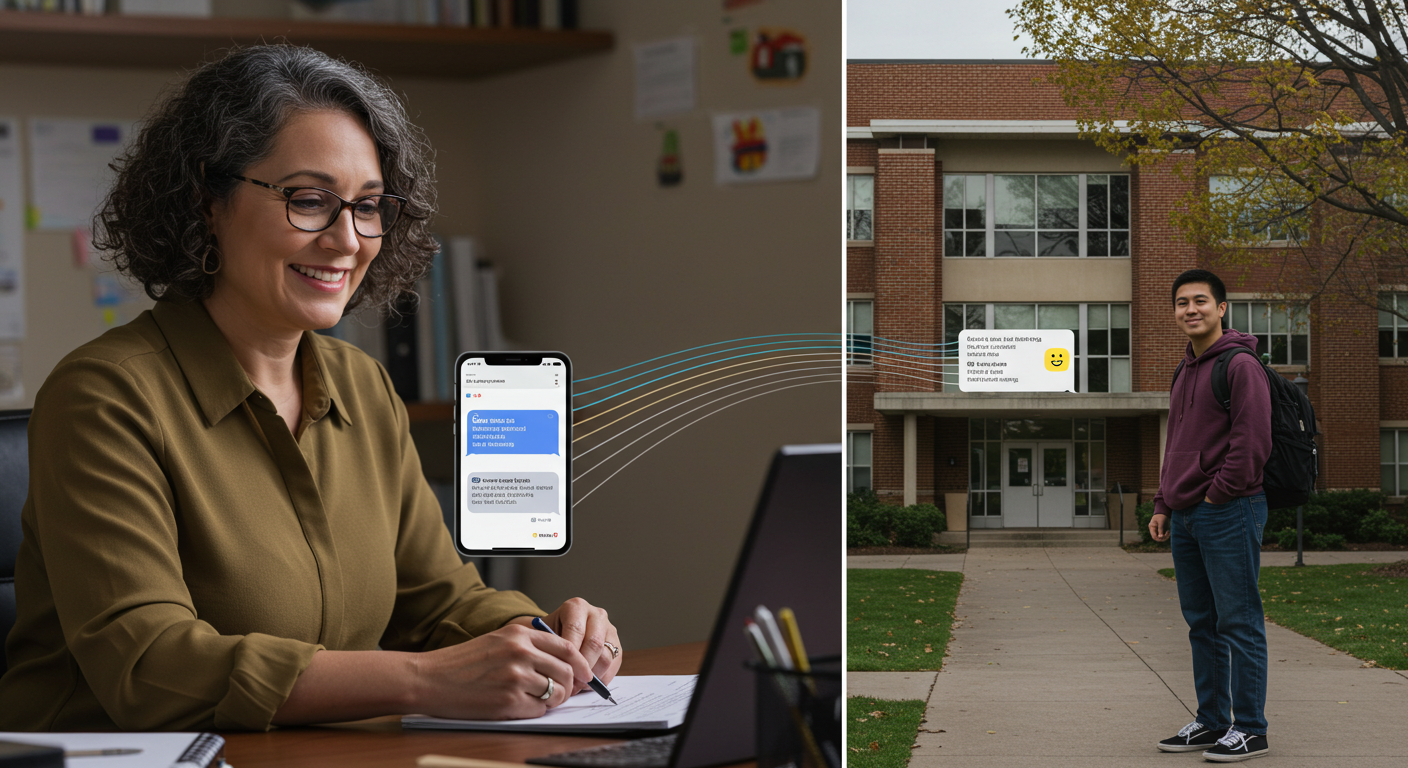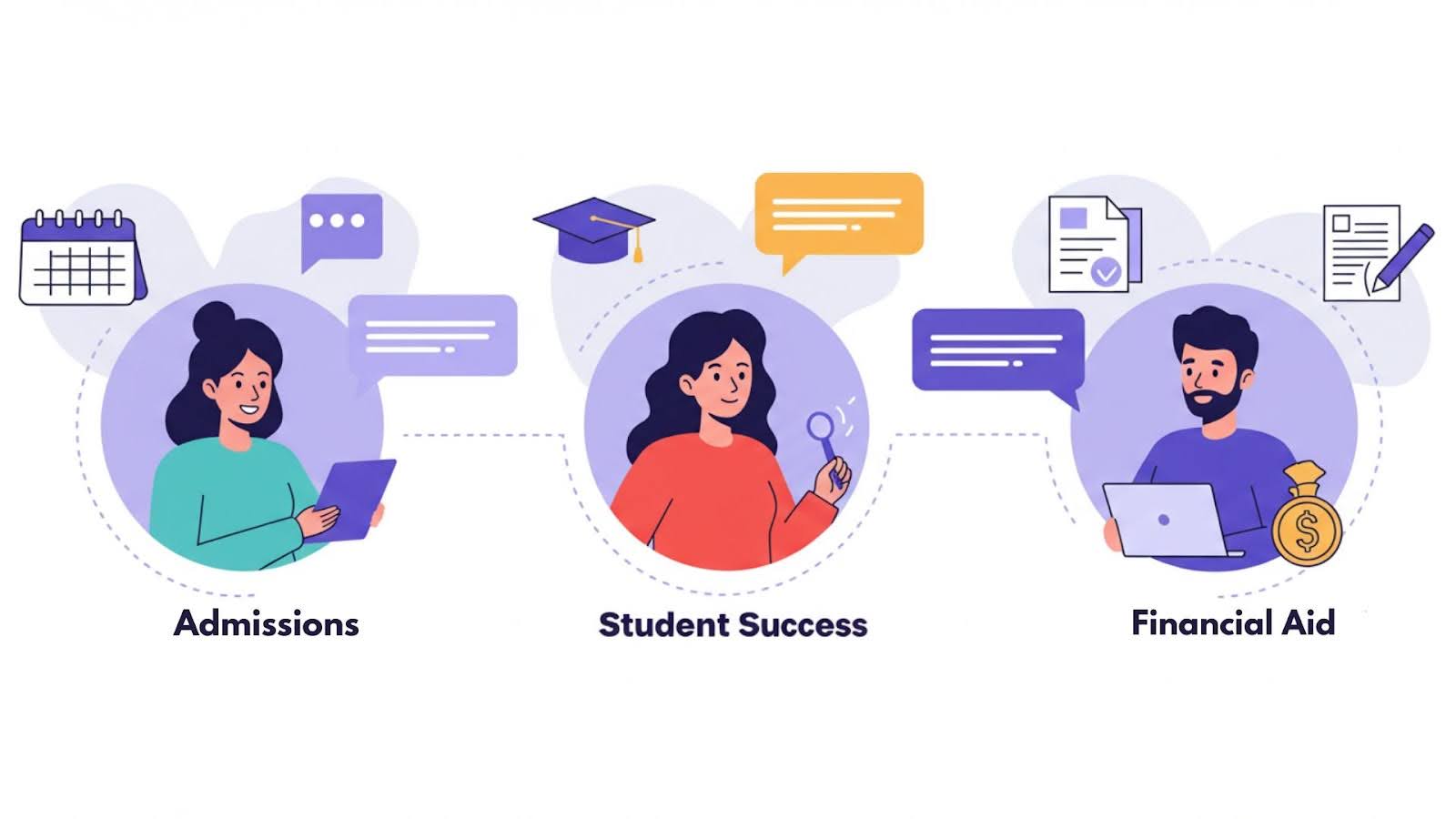The Rise of Text Messaging Platforms in Higher Education Communication
Students are constantly bombarded with information across multiple platforms, and higher education faces unprecedented challenges in maintaining effective communication. Traditional email outreach has seen declining engagement rates, with research indicating that only 25–33% of institutional emails are opened by students.
Meanwhile, text messages boast an impressive 98% open rate, with most messages read within three minutes of receipt. This stark contrast reveals why forward-thinking colleges and universities are adopting higher education text messaging platforms to meet modern learners where they already are: their smartphones.
Today's students, predominantly Gen Z and Millennials, expect seamless, immediate and personalized communication from the institutions that serve them. Yet many institutions still rely on fragmented communication systems that create disconnected student experiences and administrative inefficiencies.
As higher education faces challenges with dropout rates and financial fitness, text messaging has emerged as a powerful solution to combat "summer melt," boost retention, streamline administrative processes and create the responsive, personalized experience that students demand from their educational journey.
Why Higher Education Text Messaging Platforms Are Becoming Essential Tools
Student communication has undergone a dramatic transformation in recent years, driving institutions to adopt more innovative approaches to connect with their students.
Meeting Modern Students on Their Preferred Devices
College students are digital natives who view their smartphones as essential tools for navigating daily life. According to a study by Pew Research Center, 98% of Americans between 18 and 29 years own a smartphone, with the average person checking their phone 58 times per day. About a quarter of Gen Z students admit that they spend too much time on their phones.
This mobile-first mindset creates both challenges and opportunities for higher education. While email remains the official communication channel for most colleges and universities, it's increasingly becoming a secondary consideration for students. Higher education text messaging platforms bridge this gap by meeting students on their phones. These platforms enable institutions to send important reminders, deadline notifications and personalized guidance directly to students' most-checked device, increasing the likelihood of engagement and action.
Breaking Through Digital Noise in an Age of Information Overload
The average college student is bombarded with thousands of digital messages daily across various platforms, from social media to emails and notifications. This information overload has created significant challenges for institutions trying to ensure critical communications aren't lost in crowded inboxes or social media feeds.

Text messaging cuts through this digital noise with unmatched effectiveness. With character limitations and immediate delivery, SMS forces communicators to be concise and direct. A study found that approximately 70% of students who received text messages enrolled in college compared with 63% who were not texted, demonstrating the tangible impact of this communication channel.
Key Benefits of Implementing an SMS Strategy in Higher Education
Institutions implementing higher education text messaging platforms are discovering significant advantages across multiple operational areas and student touchpoints.
Immediate and Direct Communication During Critical Periods
The timeliness of communication can make the difference between student success and failure at key junctures. Higher education texting platforms excel during these high-stakes periods. Summer melt (when students who have been accepted to college and indicated their intent to enroll fail to matriculate in the fall) represents one of the most critical communication challenges for institutions. According to data, this phenomenon affects 10–20% of would-be students across all institution types, with rates climbing even higher among low-income students and those bound for community colleges.
Text messaging has proven particularly effective during these transition periods because of its immediacy. Unlike emails that may sit unread for days, text messages are typically opened
within minutes of receipt. Immediacy allows institutions to provide timely guidance when students encounter barriers like incomplete financial aid forms, registration deadlines or housing applications.
Beyond enrollment, strategic texting helps institutions maintain momentum throughout the student lifecycle. Financial aid offices leverage text reminders for FAFSA completion and verification requirements, improving compliance rates. Registrar's offices use timely SMS notifications for registration windows, payment deadlines and outstanding requirements, creating smoother operational workflows for both staff and students.
Higher education texting platforms deliver the right message at precisely the right moment, when students are making critical decisions or facing important deadlines, converting potential drop-offs into successful completions.
Personalized Engagement Throughout the Student Lifecycle
Modern higher ed SMS platforms integrate with student information systems (SIS) to deliver highly personalized communications based on a student's specific circumstances, needs and stage in their educational journey.
Personalization transforms texting from a mere notification tool into a powerful engagement platform. For example, instead of sending generic reminders about registration deadlines, institutions can tailor messages based on a student's major, year in school, outstanding requirements and past behavior. Research shows that personalized text messaging yields a 45% student response rate.
The impact of personalization is particularly evident in student success initiatives. Targeted text-based interventions for academically at-risk students have proven effective in improving course completion rates across higher education.
When messages include specific, actionable guidance rather than generic encouragement, students are more likely to take concrete steps toward academic success. These personalized nudges help students navigate challenging coursework, connect with available resources and stay on track with assignments and deadlines.

By providing timely reminders and tailored advice at critical moments in the academic journey, text-based support systems can transform what might have been a withdrawal or failure into a successful course completion, especially for students who might otherwise fall through the cracks of traditional support systems.
Enhanced Accessibility for Diverse Student Populations
Institutions serve increasingly diverse student populations with varying needs, schedules and communication preferences. Higher education text messaging platforms help bridge accessibility gaps for several key demographics.
For first-generation college students who may lack familiarity with institutional processes, text messaging provides clear, digestible guidance through unfamiliar terrain. Research has shown that first-generation students who receive strategic text message support are more likely to complete key enrollment steps than peers who do not. Timely notifications help demystify complex college processes and provide just-in-time support when it matters most.
Similarly, for working adult students juggling professional, personal and academic responsibilities, text messaging offers necessary flexibility. Unlike phone calls that require immediate attention or emails that may be overlooked, texts can be quickly scanned and responded to during brief breaks in busy schedules. Adult learners frequently cite text messaging as their preferred institutional communication channel because it accommodates their schedules and allows them to engage on their own terms.
Higher Ed SMS Platform Applications Across Campus Departments
Higher education texting platforms are versatile tools that serve diverse functions across different institutional departments, each addressing unique communication challenges.
Admissions and Enrollment Management
Admissions departments are often early adopters of SMS technology, recognizing its power to guide prospective students through complex enrollment processes. From initial inquiries to final enrollment confirmation, strategic text messaging creates a continuous communication thread that reduces uncertainty and builds commitment.
For prospective students, text messaging creates a personalized experience starting with their first expression of interest. Multiple institutions have found that implementing two-way texting for admissions inquiries increases application completion rates and dramatically reduces response times from days to minutes. The conversational nature of these exchanges helps humanize the institution early in the student journey.
Student Success and Retention Initiatives
Student success departments leverage higher ed SMS platforms to deliver timely interventions, nudges and support throughout the academic journey. These tools reach students at pivotal moments when small actions can prevent larger problems.
Early alert systems paired with text messaging enable rapid response to warning signs like missed classes or declining grades. Students receiving text-based interventions following academic alerts are more likely to utilize support services and improve their academic standing than those receiving only email notifications.
Text messaging facilitates ongoing engagement with campus resources. From promoting tutoring services to reminding students about mental health resources, these nudges help connect students with valuable support systems before small challenges become retention-threatening issues. Institutions using strategic text messaging for resource promotion generally see higher utilization rates for student services compared to those relying primarily on email and posted notices.
Financial Aid and Administrative Communications
Financial matters represent some of the most consequential and often confusing aspects of the student experience. Higher education texting platforms have proven particularly valuable for financial aid offices seeking to improve compliance, reduce confusion and minimize administrative barriers.
Text-based reminders about FAFSA filing deadlines, verification requirements and award acceptance steps have generated positive results across institutions. Schools using targeted SMS campaigns typically see reductions in incomplete financial aid applications and decreased missed deadlines compared to historical averages.
The efficiency gains extend to other administrative areas as well. Bursar's offices using text messaging for payment reminders report reduced late payments and fewer accounts sent to collections. Similarly, registrar's offices leveraging SMS for registration reminders, deadline alerts and outstanding requirement notifications see higher on-time completion rates and fewer last-minute rushes, creating smoother operational workflows for both staff and students alike.

Best Practices for Implementing Higher Education Texting Platforms
Successfully implementing a text messaging strategy requires thoughtful planning, clear protocols and ongoing optimization. Institutions that excel with texting platforms have developed specific approaches that maximize engagement while respecting student preferences.
Developing Effective Messaging Protocols and Governance
Before sending the first message, establish clear governance structures that define who can send messages, when they can be sent and what content is appropriate. Create a cross-departmental committee to develop institution-wide texting policies that prevent message fatigue and maintain professional standards.
Categorize messages by urgency and importance to determine the appropriate sending frequency. Emergency alerts require different handling than promotional messages or reminders. Document these distinctions in your messaging protocol and train all users accordingly.
Privacy considerations should be at the top of the list when establishing your higher education texting platform guidelines. Ensure your protocols address opt-in procedures, data security and compliance with regulations like FERPA. Clear documentation of consent processes legally protects your institution and builds trust with message recipients.
Balancing Automation with Personalized Human Connection
The most effective texting strategies blend automation with authentic human interaction. Use automated workflows for routine communications like deadline reminders and appointment confirmations, but incorporate personalization tokens that make each message feel individually crafted.
Reserve truly personal outreach for high-impact moments in the student journey. When a student exhibits warning signs like missed classes or declining grades, a personalized message from an advisor carries significantly more weight than an automated alert. Train staff to maintain a conversational, supportive tone that conveys genuine concern.
Develop escalation pathways that seamlessly transition from automated messages to human interaction when needed. If a student responds to an automated reminder with a question or concern, ensure your higher ed SMS platform routes that conversation to an appropriate staff member who can provide timely assistance.
Measuring Impact and Optimizing Communication Strategies
Establish clear metrics that align with your institutional goals before launching your texting initiative. Beyond basic engagement measures like open and response rates, track behavioral outcomes such as appointment attendance, form completion or resource utilization that directly impact student success.
Create a regular review cycle to evaluate message effectiveness across different student segments. Different demographics may respond better to varied messaging styles, timing or content types. Use these insights to continuously refine your approach rather than applying a one-size-fits-all strategy.
Collect qualitative feedback about your texting program through periodic surveys or focus groups. Students can provide invaluable insights about which messages they find helpful versus intrusive, the ideal frequency of communications and content that would better serve their needs. This feedback loop ensures your higher education text messaging platform evolves to meet changing student expectations and communication preferences.
Transform Your Institution's Communication Strategy Today
Adopting higher education text messaging platforms impacts how institutions connect with their students. As digital natives increasingly populate campuses, SMS communication has evolved from a convenient option to a strategic necessity.
The most successful institutions recognize that text messaging is a powerful engagement tool that can guide students through critical decision points, deliver timely support during moments of need and create more accessible pathways to resources and services. When implemented thoughtfully with clear governance, personalized approaches and continuous optimization, texting platforms can dramatically enhance the student experience while improving operational efficiency across departments.
At Modern Campus, we understand the unique communication challenges faced by higher education. Our Message platform addresses these needs, combining research-backed blended messaging approaches with intuitive workflows that make it easy to connect with students at scale.
We've seen firsthand how our clients have reduced summer melt, improved student persistence and created more responsive administrative processes through strategic text messaging. Our platform integrates seamlessly with your existing systems while offering the flexibility to evolve with your communication strategy. Contact us today for a personalized demonstration of how Modern Campus Message can help your institution build stronger connections with students throughout their educational journey.
Last updated: May 14, 2025



